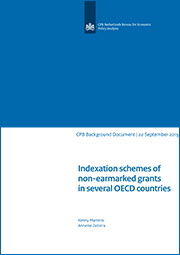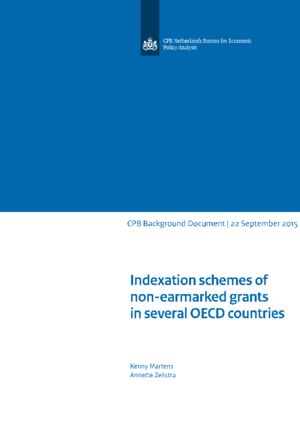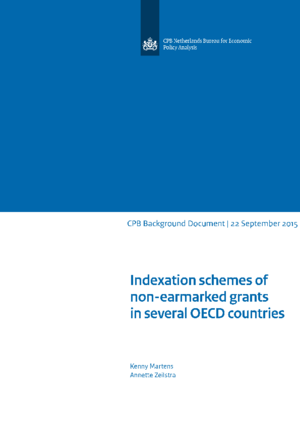Indexation schemes of non-earmarked grants in several OECD countries

In this context, CPB Netherlands Bureau for Economic Policy Analysis was asked to investigate the current indexation of the largest non-earmarked grant that is allocated from the central government to the municipalities and explore alternative ways of indexation.
The indexation schemes used in the nine OECD countries differ widely. Most countries have chosen to determine the size of their largest non-earmarked grant using an elaborate system. Other countries are basing their indexation scheme on the inflation rate, the development of central government tax revenues, or on a fixed growth rate, or they do not index their grant.
Almost all municipalities experience an increase in costs due to demographic changes, depending on their tasks. Municipalities in Denmark, Finland, the Netherlands, Norway, Sweden and Belgium are all responsible for elderly care. Therefore, their expenditure increases as the number of elderly people increases. Municipalities in most of these countries are compensated for an increase in these types of costs.
Moreover, in all countries, municipalities see their local tax revenues drop under large negative macroeconomic shocks. In addition, municipal expenditure in some countries increases as a result of such shocks. However, most indexation schemes do not account for macroeconomic shocks. In Portugal and Spain, the largest non-earmarked grants even decrease as a result. Only in Denmark are municipalities, usually, fully compensated for an increase in expenditure and a decrease in local revenues that result from negative macroeconomic shocks.
In most countries, a first estimate of the total non-earmarked grant is allocated before the end of July – and a final estimate around the end – of the year preceding the year in which the grant is provided. Some countries modify the size of the grant during the year in which the grant is allocated for all the municipalities or in the two years thereafter.
The stability and forecastability of their largest non-earmarked grants varies between countries and depends on the type of indexation scheme that is used. In some countries, the stability of the grant depends on the development of the inflation rate or the central government tax revenues. Countries that apply a fixed growth rate tend to perform well on stability and forecastability. The Belgian region of Flanders is an example of where the largest non-earmarked grant grows conform a fixed growth rate. The disadvantage of such a mechanism is that the indexation scheme does not account for the effects of demographic changes and macroeconomic shocks.
Finally, there seems to be no obvious relationship between the share of the largest non-earmarked grant in the municipal income and the type of indexation scheme. However, its share in the total municipal income tends to be below average for countries that have adopted a fixed growth rate.

